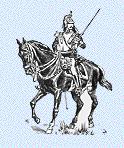Remmick.Home.Site Page 46
Russian Harvest
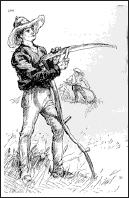
Tools, Machines, & Other Items Needed for Harvesting Grain
Baskets:
Baskets were not usually made by farmers or their families but purchased from the wandering peddler who always held a variety of different kinds of baskets the peddler had purchased from the men, women and children who made them for their living and usually lived near a lyman where the reeds could be fathered and used. They were simple and cheap or very expensive and ornate.
See Step Four for picture of basket.
Double Handled Sowing Basket- The woven wicker basket had two handles on the one side and straps could be slipped through and it could hang around a person's neck if a person sowed seeds with both hands. There were a variety of shapes and sizes and each person found one that suited him or her if possible. On the opposite side of the handles was often found a "stave" with which a person could use to steady the basket if needed.
Those who did not use baskets could have used a "sowing sheet" that was like a sling made of heavy canvas and used by someone who used only one hand to sow the seed.
The seed fiddle [bag] was canvas and had a wood frame with a strap around the sower's neck and rested on the sower's chest. It could hold up to seven pounds of seed.
Binders:
Dibbers:
Drills:
Harvesters:
Harrow:
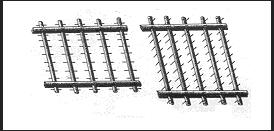
Plows [Ploughs]:
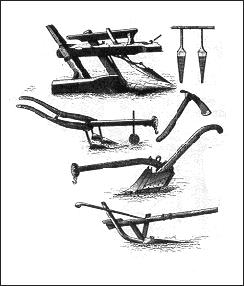
The first plow was a man's finger, than a stick, a bone and slowly through the ages wood and metal developed into forms being pulled behind a tractor which we know and recognize today .
This tool was needed to break the soil and prepare it for seeding. So, the better and stronger the plow, the easier it was for the farmer.
By 1840 the plowwrights and blacksmiths were creating more than eighty different types of plows. To name a few:
- swing plow - worked on least favorable soil
- wheel plow - made plowing easier ; depth of the plow would change in height
- double furrow plow - cut separate furrows at the same time
- multiple plow - an invention which worked best after the tractor was invented; a three furrow plow
- turn-wrest plow - sliced furrows in one direction
- paring plow - removed shallow slice of turf with a flat share to remove surface growth
- ridging plow - lifted up two ridges to form a hollow into which see could be sown
- sulky [gang] plow - driver could be seated and farmers preferred the single furrow-wheeled plow with it
- potato lifting plow
- steam balance plow
- subsoil plow
- draining plow
- disc plow
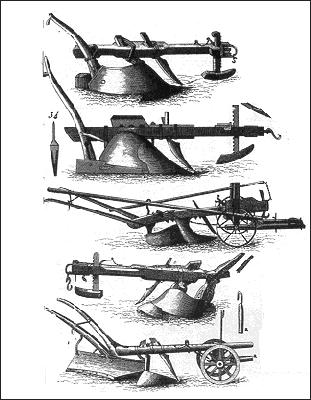
From what I understand from the Schweikert Family tales, when the German-Russians first migrated into Russia they purchased what was being sold by the Russians or had German plows. However, because of the vegetation and the virgin soil, these plows twisted into useless piles of metal. Fortunately, the Schweikerts and other Germans who had lived for a time in Poland had discovered the "Polish Plow" which was stronger in two ways. The beam was arched and medal for the blade was a new mix called "cast iron", later, came the mix of metal called steel [1837]. According to Joseph S. Height's book HOMESTEADERS ON THE STEPPE, The Odyssey of a Pioneering People, p. 324, the first steel plow was made by John Deere. He gives credit to Arnold Bechtel of Freudental who produced the first iron plow in S Russia in 1840. It could plow four acres a day. Bechtels, Schweikerts, Henks, Hohns and others couldn't turn the "new" plows ["colonist plows"] out fast enough because the demands were so high.
The Schweikerts of Borodino / Bess. invented new kinds of plows, one of them was the two-ply plow which was shown at the largest Russian Fair and won all kinds of awards.
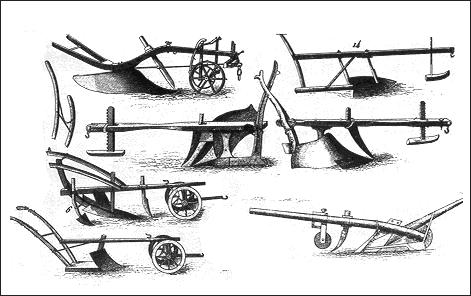
Seeder:
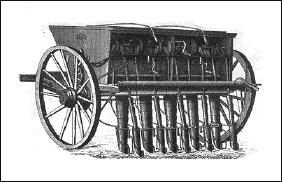
Sickle and Scythe:

According to family tales and history there are different tool connected with the harvest of gain. From what I understand the ancient Egyptians harvested wild and cultivated corn with a primitive form of a sickle. Evidence tells us the first sickle was made from the jawbone of a large animal which had teeth sharpened down to form a cutting edge. As man progressed through the centuries, man developed better tools. A sickle was a wooden handel and an iron curved blade. The early German-Russians used these sickles to cut grass and grain crops. The process was slow, hard on the back, hands and legs. Different kinds of sickles had been invented for different chores. The "reaping hook" had a cutting edge of about 18 inches long, was curved with tiny teeth which was connected to a short wood handel. This was used for corn. The "bagging hook" was not as curved as the "reaping hook" and it's blade was ground down to a thin sharp cutting edge used to "hack" over the corn which sped up the harvest because the blade didn't have to "cut" but "hacked down" the stalks. The "reaping scythe", also known as the "cradle scythe", replaced the sickle for reaping corn and was found to work well on grasses and grain. The blade was about 40 to 48 inches long but straight accept for the last several inches. The handel was long and had two handles which allowed greater ability to cut. The HAINAULT SCYTHE originated in Flanders during the Middle Ages..... It was found to cut one third more each day than the "reaping hook". Variations were added to the Hainault scythe and it produced what is called the "mowing" scythe. And this was used in the early 1900s.
Threshing Machines:
Tractors:
It was not until WWI that man and horse power plus food shortages which caused the tractors to catch hold in the USA, but, even in the 1990s the Russian steppes still see the old ways, scythe and horse drawn plows more often than not.
By 1918 all kinds of tractors were coming into their own and continue to be developed today ass we near the year 2000.
Wagons & Carts:
- carts - simple platform of rough wood planking with sides, it was fastened to an axle with solid wheels
- trumbils - body of the platform could be titled up and the front and contents spilled out at the back, fasten to axle and wheels
- hay or corn cart - cart that was elongated and used at harvest time, the wheels were usually wider and rimmed with convex iron tyres which prevented the damage of grasslands
- cattle cart- built lower to the ground for the ease of loading sheep, pigs, cattle, etc. unto it's platform that held sides suitable for the beast it was carrying, some were covered to protect beasts from foul weather.. The axel and wheels were made to hold the weight..
- pony cart - light cart which the farmer drove to the market or a child guided it's pony
- farm wagons - the frame was heavier and larger about eleven to fourteen or eighteen feet and the wheels were spoked with the diameter of four to five feet with metal rims and it took a wheelwright and a wagonwright far longer to build
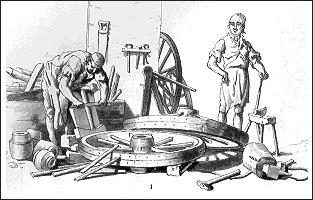
|
Wheels Wheels were complex and needed more than a carpenter or a blacksmith to produce a finished product that was needed for a heavy farm wagon.. |
Winnowing Forks:
The Various Steps from Plowing, Seeding, Sowing to Harvest
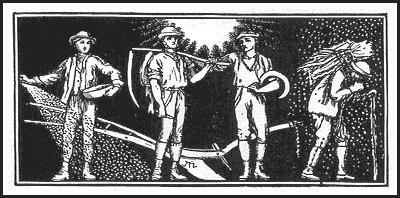
Step One - Buying the Seed:
Step Two - Pickling wheat:
If one was fortunate, they had "wet wheat pickling machines".
Step Three - Plowing:
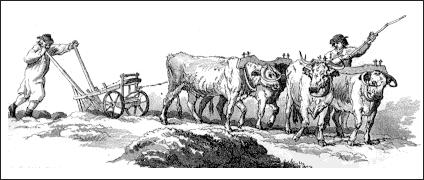
"It was always quite an event when the plows were hitched up for the first time after winter."
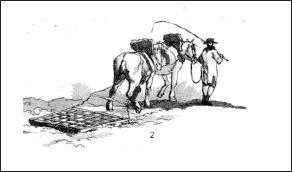
If the ground was in need of being leveled, a harrow was dragged behind an ox or horse.
Step Four
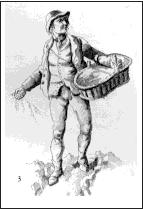
Step Five
Step Six:
Step Seven:
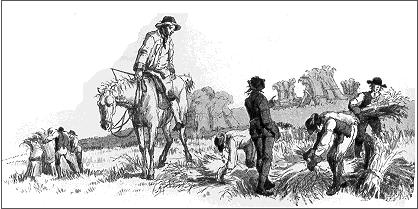
In olden times the fields were cut with Sickle and scythes then each stack was bound with twine by hand. In later times it was the mower that cut, the raker followed and then the binder that tied the stalks and grain into bundles.
In the "olden times" all the cut grain was brought to the farm yard to be thrashed.
Step Eight:
The bundled stalks or sheaves were unbound and spread out on the threshing floor. Not too thick and not to thin.
Horses or oxen were hitched to the wheel on top of the grinding stone and the beasts were made to walk around and around as the stone loosen the grain from the shaft..... The stone and beasts were removed and the shaft and chaff was lifted off ["shaken"] with winnowing forks and let the wind blow what was left free of the sheaves to fall to the floor.
The kernels of grain were collected.... If there were hard kernels that hadn't separated, these were given the "riding off" which meant they were returned to the floor and stone and reground....
Step Nine:
Step Ten:
Step Eleven:
Business ended at the buyer's office, Kontor, near the railroad or the port stations.
According to Weigum and others, the villages or town or cities resembled a huge gathering place for everyone concern, even the Jewish men who loaned money. A sea of empty wagons were parked near stores where they would be loaded with items bought to take home.... Meanwhile, the horses were unhitched and taken to be watered and cared and feed... If one had the money, the horses were taken to stables of an Inn....
Lanterns were burning everywhere when darkness fell and a person was still in town. Older children and reliable servants watched the wagons and horses to prevent thieves from taking anything that didn't belong to them...
Outside the stores were booths of all kinds.... One could buy all kinds of nuts, especially the sunflower seeds , which were the most popular or Halava [Halwa], or Busa [an alcohol-free drink made from millet], lemonade with ice....french rolls, kringles [sweet roll] that had been deep fired..... Sausages of different kinds not made at home.... Lamb ka bobs sent a marvelous order into the air....All kinds of fruits were sold....
One of my grandfathers Ludwig Hein's favorite fruit was the Crimean apple, a Snapy [Synappy ], that was greenish-yellow with one red on just one of it's elongated side.... There was another apple that was green and it's skin was transparent and the flesh was very sweet and juciey....
Children usually fell asleep if they could after telling ghost stories before midnight.
The men stayed up very late as they gathered in various ways and places to talk about the old times, news of the world, or whatever they liked to talk about, while they drank tea and from time to time a glass of snapps, and, smoked their newly purchased tobacco. in hand carved pipes that were as different as the men who smoked them.
Morning came too soon for most.
Step Twelve:

|
|
See GRAIN HARVESTS |
Russian Grain Harvest This Page |
